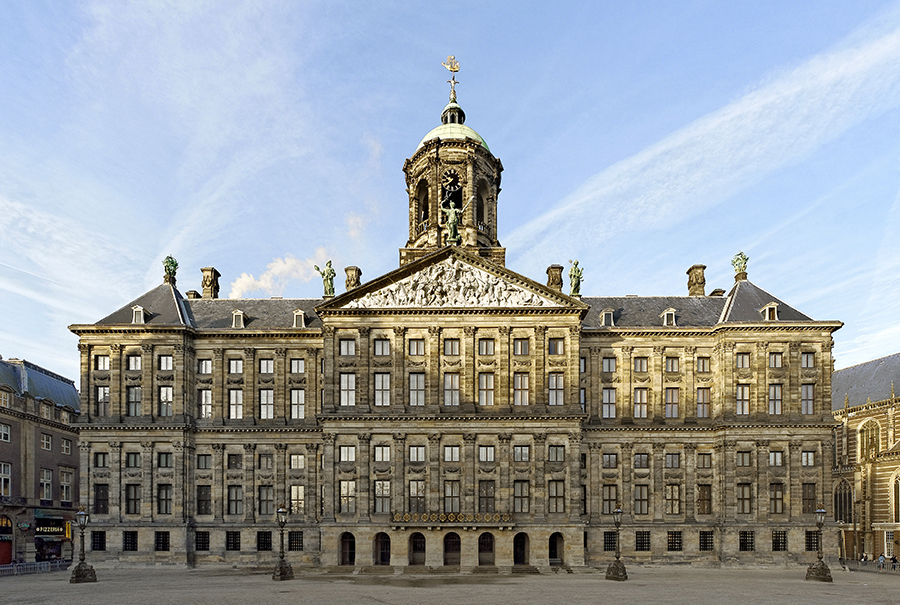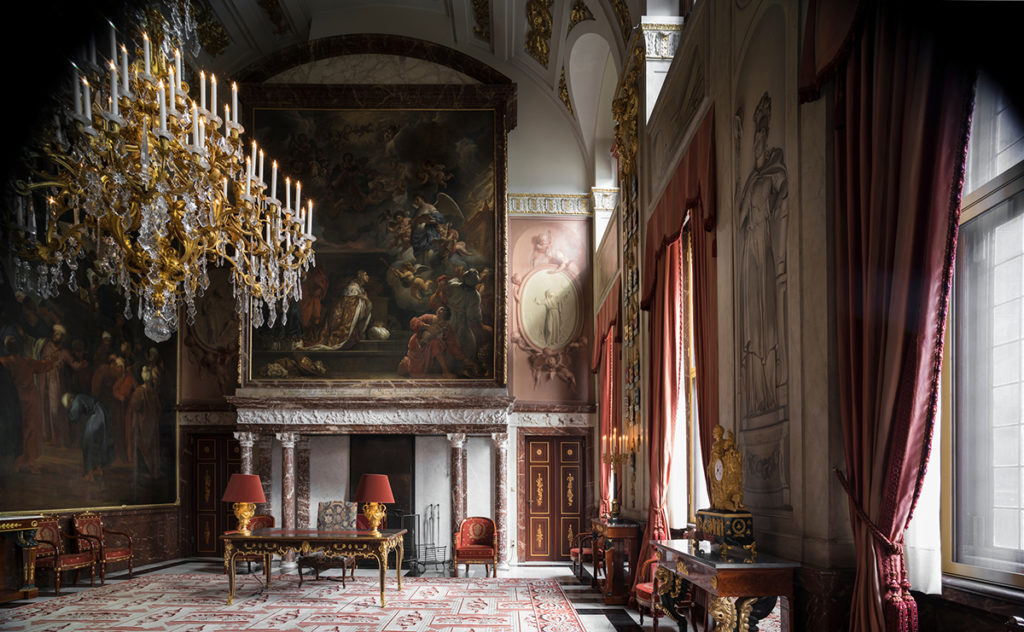The Royal Palace

Amsterdam is a perfect place to visit for the arts of the seventeenth century. The city center and its canals are an open-air museum of golden age-architecture. But there is one site especially you shouldn’t miss. The Royal Palace on Dam Square might be the best example the Dutch glory of the past. And it houses some of Amsterdam’s best-hidden art gems.
City Hall
Even though the name of the building suggests otherwise, the Royal Palace was not originally intended as a palace. It was constructed to become the new town hall of Amsterdam after the earlier one burned down in 1652. This new building had to become special according to its builders. Halfway through the seventeenth century, Amsterdam was the most powerful commercial center in the Western world. It had recently played a significant role in establishing peace in the Dutch Republic. The city’s successes needed to be reflected in the design of the new town hall. The architectural assignment was as ambitious as the city itself: to underline Amsterdam as a powerful city and to be a monument for peace at the same time, an ‘Eighth Wonder of the World.’

Dutch Classicism
To achieve this, the city council turned to prominent architect Jacob van Campen. He designed the building and its sculpted decorations to form a universe on a small scale and a tribute to God’s creation. He worked in the style of Dutch Classicism. It meant that Van Campen reinstalled the building principles of the Antiquity, with elements like building in a symmetrical fashion and adding classical decorations and pilasters. This explains why the front of the palace looks like a classical temple. Inside, the times of the ancient Greeks and Romans revived through the marble sculptures and paintings featuring classical scenes and figures.
Changing times
Since the building was so large, it housed a number of functions in the seventeenth century. First of all the mayors and city councils, but also an exchange bank, insurance offices, even a court and several jail cells. Many people entered the building on a daily basis to settle their affairs. But while the seventeenth century was a golden one for the Netherlands, the eighteenth had a different theme. The Republic entered a crisis, with many people questioning and eventually opposing its leaders. When the French Revolution erupted in 1789, shock waves were felt throughout Europe. Amsterdam was no exception. In 1795 Dutch Governor William the Fifth fled from to England. French troops entered the country, proclaiming the Batavian Republic and effectively making the Netherlands French territory.

by Arjan Benning
French Royalty
In 1806, Napoleon Bonaparte made his brother Louis the first King of Holland. He needed a place to live. What building could be better suitable for the needs of a king than that grand, wonderful town hall of Amsterdam? He started living here, transforming it from a draughty, cold business place to a comfortable city palace. And the building has stayed royal ever since. Louis Bonaparte was sent off the Dutch throne by Napoleon in 1810, making it the imperial palace of the French Empire for a short amount of time. Napoleon and his wife even stayed here for a few weeks in 1811. When the son of Governor William V returned to the Netherlands in 1813 and became the first Dutch king (William I) in 1815, it was only logical he was offered the royal palace.
Restoring the glory of the past
The Royal Palace was sold to the Dutch State in 1936. Ever since, carefully planned restorations have made the interior the hidden gem it is today. The Empire furniture has been restored. The patterns in the carpets are the same as those of Louis Bonaparte’s. In other rooms, a seventeenth-century pattern decorates the walls and curtains. Paintings representing the Dutch Royal family were added to the interiors. Today, the Royal Palace serves as an official palace. The present Dutch King Willem-Alexander uses it for official events, like state visits and other official receptions. It is also the setting for the monarchy’s most important moments such as royal weddings and the abdication and investiture of the head of state of the Netherlands. In between these events the palace is open to the audience for up to nine months a year. It is a unique opportunity to wander about in the only Dutch palace in official use that allows visitors. For a sneak preview of its marvelous interior, visit the excellent virtual tour online through their website.
Contact

Most Popular
-

Nightlife & Entertainment
The Upside Down is an immersive visual experience for creators
You can call it an instagram museum, an experience or a selfie heaven
-

Attractions
The 15 Best Things To Do in Amsterdam
Local tips and must sees for an unforgettable experience in the capital of Holland
-

Attractions
A’DAM Toren
A vertical city offering 24-hour entertainment
-

Nightlife & Entertainment
Audiovisual spectacle AMAZE is a new way of going out
Festival organizer ID&T presents an immersive experience of light, sound and thrills
-

Attractions
The Royal Palace
The Architectual Highlight of the Golden Age

Attractions
The Royal Palace
Amsterdam is a perfect place to visit for the arts of the seventeenth century. The city center and…
Center

Attractions
Holland Casino
Try your luck in Holland Casino Amsterdam! Holland Casino Amsterdam is located right in the centre of the…
Center

Attractions
The 15 Best Things To Do in Amsterdam
So, you’re coming to Amsterdam and might only have 72 hours or less to explore the city. Good…
Amsterdam Centrum

Attractions
Audiovisual spectacle AMAZE is a new way of going out
AMAZE Amsterdam is an immersive 1-hour audio-visual walk across an area of 3,000 m². In 7 separate stages,…
West

Attractions
Above NEMO
Every year as spring eases in to summer, urban areas around Amsterdam transform into city “beaches”. BovenNEMO (‘above…
Center

Attractions
A’DAM Toren
A'dam Toren is Looming tall over the Amsterdam North skyline. This landmark 22 story tower is home to…
North
















